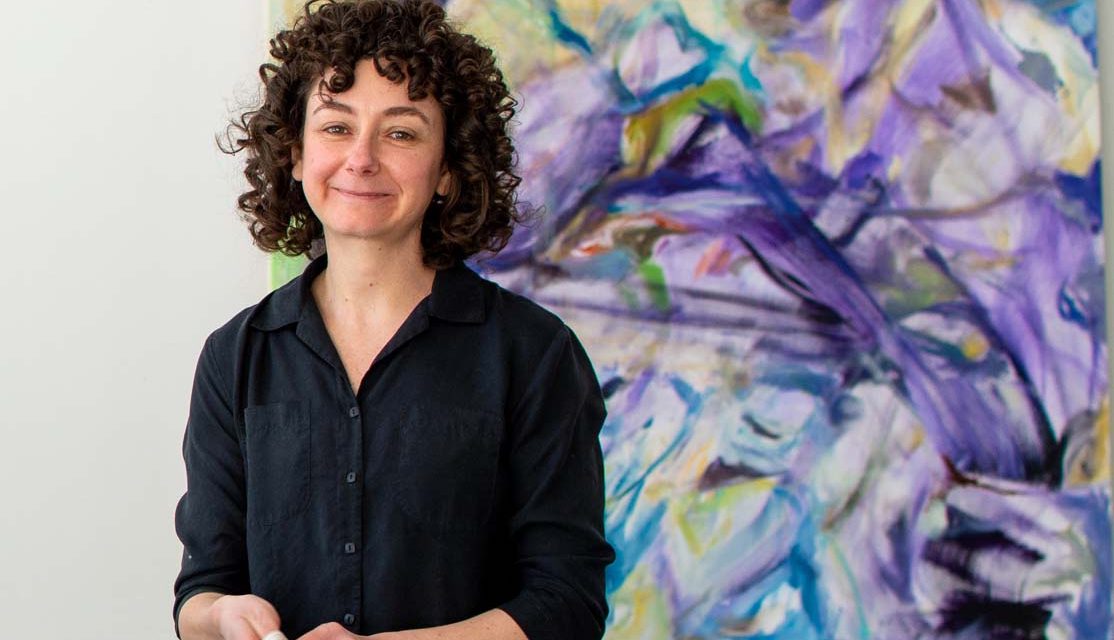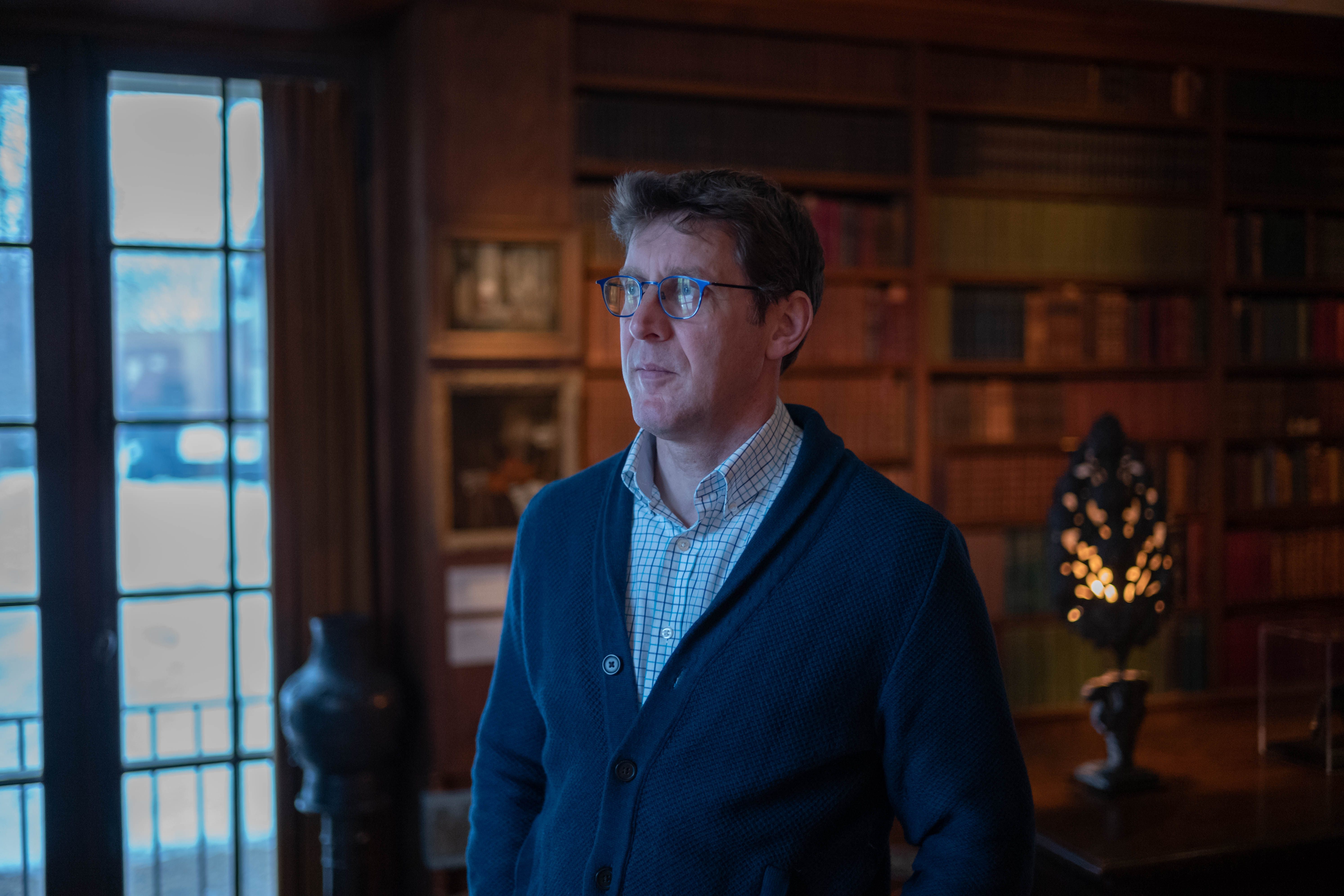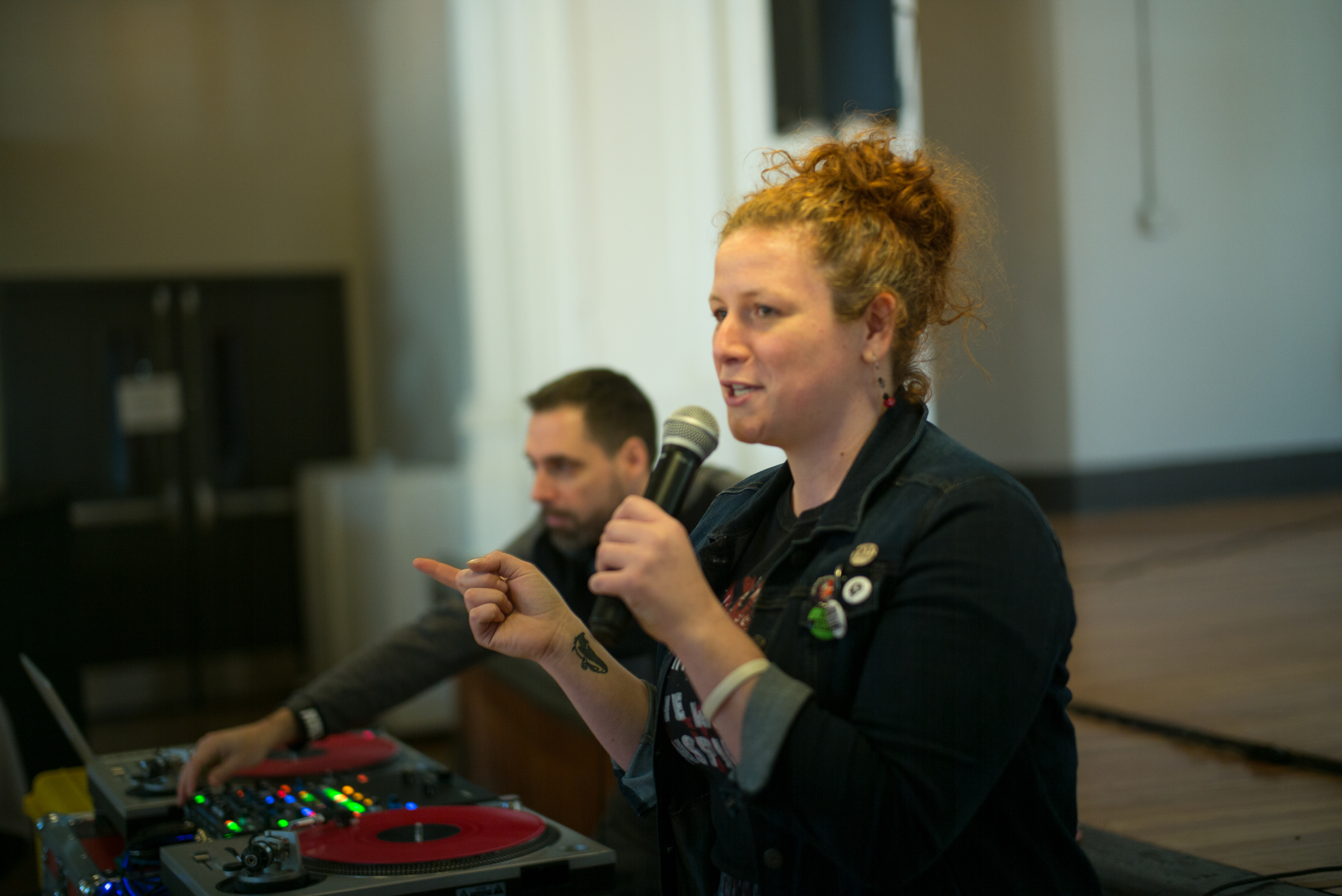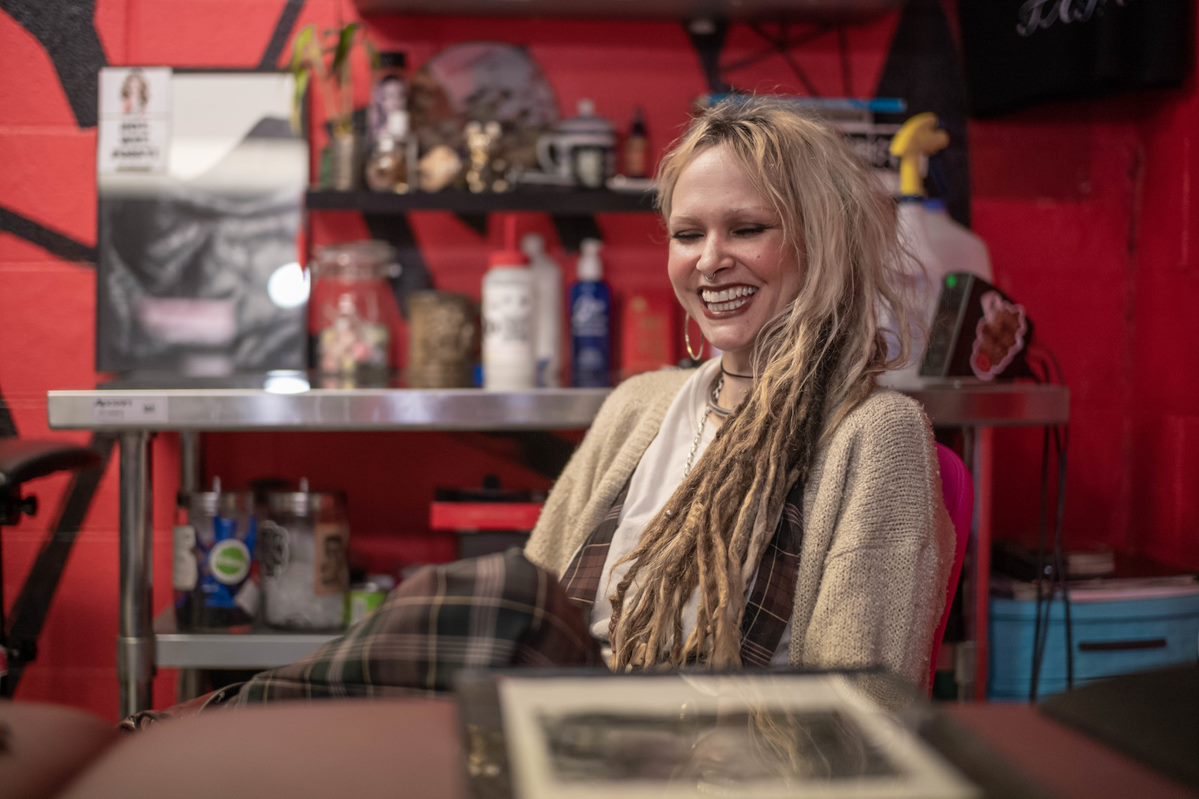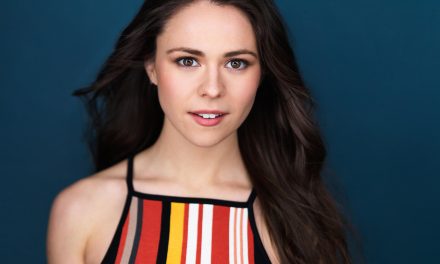(Photo credit: Susan Lynch Smith)
Visual artist
Age: 36
Current hometown: East Chatham
Current project: Prepping for a solo show at Gold/scopophilia in Montclair, N. J., running April 24-June 5, 2021; and a 2022 show at September Gallery in Hudson
Collaborative Media’s Maker of the Week is made possible by KeyBank.
Growing up on a farm and nurturing a lifelong fascination with horses helped Ashley Garrett to establish her mind as fertile territory for the seeds planted by her frequent interactions with nature. Much like an oyster responds to an outsider in its shell by producing a pearl, Garrett allows those seeds to blossom into abstract drawings and paintings. Her artistic approach is less about planning what she wants to say than it is about listening to what the work itself seems to want to become. For others willing to listen, each of her works has a fascinating story to tell.
This past year, Garrett handled the pandemic with aplomb; after agreeing to multiple postponements of “Aegis,” her first solo exhibition at September Gallery, she and gallery owner Kristen Dodge managed to mount a socially distant, in-person summertime show. During the holidays, she delved into making Moravian star ornaments that were a nod to her first undergraduate college and were also used to benefit Perfect Ten, a girls’ afterschool program in Hudson. Some of her work also will appear in the upcoming group show “Vision of Care” at the Woodstock Artists Association & Museum; in the annual BAM Art Auction opening in June; and on the Spring 2021 cover of poetry magazine SALT.
We spoke at the start of February, just as the winter weather was providing her with fresh inspiration.
On your website, you talk about things like growing up on an animal farm and being a professional equestrian. How do those things relate to who you are as an artist?
I grew up on a farm in Pennsylvania. My parents had a menagerie of animals that did not include horses for quite a while. I was just one of those kids who was like, “Horses! Horses! Horses!” I just am obsessed, and I will not let it go — so you might as well just let me have them. (laughs) There was a farm up the road from where I grew up that was a really nice facility, Blue Valley Riding Center… I eventually got to go hang out there, as one does, and kind of just get into it gradually.
Being out in nature and dealing with the elements every day was so structurally foundational to me in the way I look at creative experience and perception, observation, inner and outer… eventually, because we had the property, we were able to get a horse who was really magical. His name was Fred. Just a beautiful red bay horse, with — they call it chrome, which is like tall white socks. And a big blaze, and his eyes were really unique… he was incredible. What a beautiful teacher he was: Just very kind, super-safe, never did anything aggressive or wrong. He took care of everyone that he was around.
There’s something about horses that makes you get into a pattern. There’s training, there’s skills you’re developing; there’s a repetition. And that was really great, to have that kind of hold my childhood experience, getting to know how I am as a rider… it’s a body feeling: You’re aware of your body, you’re aware of their body, you’re connecting in this way, you’re doing movement and you’re trying to develop a skill.
When I graduated high school, I went to a local college in Pennsylvania called Moravian College, which was also really beautiful. It’s the sixth-oldest college in the country. It has really strange ties to mystical stuff… I didn’t grow up with religion, so I was craving that. I see that now when I look back… I really wanted to connect with deep historically religious tradition that had to do with deep, deep human and alchemical, mystical history.

Was that part of the reason that you chose it?
I loved the history. The buildings were so old. I remember when I first went to tour… my mom was there, and she was very skeptical. They weren’t even sure I was going to be able to go to college; it was not a great financial time for my family. So it was like, “Uh, I don’t know, it looks expensive.” And I was just in love with the school. It was so beautiful — you know when you walk into a place, and you really get that feeling? It was more about that. And then as I got to know the history, I was like, “I am so into this place!” I loved it; I felt like I belonged there. Everything about it… there was such a feeling of deep tradition that I was missing.
Over on the South Campus, which is where the art (department) is, there are ties to the Revolutionary War… you feel like you’re really connecting to deep human history, which is what I needed. So, I went there. I found a way to go there… and it was amazing. I went there for three years. The studios there were incredible.
I had a few encounters with teachers who were coming from New York City at the time, like visiting artists, professors. I was making huge paintings, figurative paintings, really ambitious; I was so excited, I just was making tons of work. They were like, “You know, I don’t think you should be in a provincial college… you seem like a serious artist, maybe you should go to New York City.” There were a couple creeping feelings that I had of the same thing at the time… even in high school, I went to visit the city, and I was like, “Wow, this place is crazy. Just so alive — like, what is this? It’s nuts, right?”
I never even thought about going bigger. I got totally connected to this college — which I’m so glad I went to, by the way. I feel like I got a really strong foundation in liberal arts, serious reading, serious writing, thinking, critical thinking. SVA (the School of Visual Arts, in New York City) had none of those things. I mean… yes, for art, of course. But not for real writing, not for political science, not for literature. None of that existed at SVA. So anyway, I got this idea of: “You know, I think that’s right. I think I should go to New York.” I visited New York a couple more times, just to check it out… the idea of actually going to “The Big City” was really exciting, and I felt like the paintings were kind of needing that stimulation, that push.
I did need that foundation of Moravian, the beauty of it; it felt very safe, in a good way. I needed that. But then to kind of let loose and be like, “Oh, yeah, OK, New York. You’re gonna be living in weird apartments!”
Sounds like that’s quite a contrast from the way you grew up, as well.
Yes, totally. I needed that wildness — that weird human aspect of crazy stuff, where everybody’s living on top of each other… I was a waitress in a million restaurants, and I just saw everything. It was so cool to see so much life, all just kind of piled in on itself. Of course, my studio was a major downgrade from what I had in Pennsylvania! (laughs)
I really look back on that, and I’m like: “Wow, I really pushed myself.” And I’m glad I did it, because I saw both sides, as an undergrad. I was able to see both super-liberal-arts school, and New-York-full-on art school with everything that comes with that.
So growing up on the farm, getting the first horse… it sounds like these influences really shaped your worldview, right from the very beginning. Were you making art right from the very beginning, or at what point did you start painting?
I feel like I was always making twiddly-bit things in my room, like little things, little kids’ things; I did lots. The one thing I felt like I was really missing was… in high school my art teacher would not teach us oil paint, and I was really like, “Aw, dammit!” It is very toxic; there’s a lot of kids in a class, it’s hard to deal with. It’s so messy.
But everything except that… watercolor, drawing, I made little objects, little crafts; I loved crafts, you know, just that kind of handmade stuff — sewing, embroidery, latch hook. I made everything. My room was like the site of: “I’m gonna go get obsessed with something.” (laughs) I had this carpet that was like a big floral carpet… I remember when my mom got that for me, and she looked at me and she was like, “You’re not gonna get paint or anything on this, are you?” And I was like (in little kid voice), “No, Mom!”… I just destroyed that carpet. She was totally cool about it, and I really appreciate that, because that thing became where I sat and I did my things. I felt great when I was in my room sitting there, just getting totally immersed in this creative world.
Being out on the land; the repetition and the structure of what the animals required, the care, the attention — all of that stuff was of a piece with the creativity. I don’t know how I can say verbally why, but it feels that that level of perception, feeling, thinking, paying attention to things, sensitivity: It all fed together. I made so many things… I mean, everything. And I did lots of weird experiments; I tried to singe the edges of a painting or a drawing one time, and had a scary moment, had to throw it in the tub… (laughs)
I’ll bet! Like a chemistry lab gone terribly wrong.
Yeah, totally… I just kinda went nuts. It was totally a lab… I can’t even pinpoint a certain moment where I was like, “Oh, I’m an artist.” It’s just kind of always there.
Could you take me on a journey from when something comes into your head to becoming a finished piece? Do you do sketches before painting, or do you just start going and see what happens? What’s your process?
What’s interesting about it, and this has always just been true, is that it’s different every time. It’s not set. I have to follow its thread, not the other way around. And that’s when I know it’s full of life and it’s directing me… I’m always following the life of it, and it will show me what it wants. If I try to impose an idea on it, that’s when I get in trouble and it’s not gonna be good.
Can you give me an example?
I’m thinking of some small landscape paintings… I went back to work at the barn that I worked at for three years after I graduated SVA, which was an amazing experience. It brought me back to the tradition of how I grew up: paying attention to animals, taking care of them, all that stuff. I went back to work there in 2017 for a period of time.
I was driving around, between my studio and the barn, and looking at the landscape. It was a little different because I didn’t have a horse of my own at the time, so I felt like my mind was more untethered, and I was really looking at the landscape. I would come back to the studio and… these paintings just kind of came out. It wasn’t like, “Oh, I’m just gonna make a painting of this hill I saw on my drive.” But I know that that’s where they came from: really looking at the landscape and the way that it moves when you’re driving. In this area, you can really see a range: really flat, almost plain-like —
Oh yeah. The terrain is all over the place.
Totally. And then there’s the Catskill Mountains, which are so gorgeous. And they just suddenly pop up, and on a day that you don’t know that they’re gonna be visible. And then there they are, they’re like “Oh, hello!” That kind of stuff. So, driving and seeing this discovery of land unraveling, unfolding; this kind of undulating land. Two paintings that came out of that, that I had no idea were gonna happen.
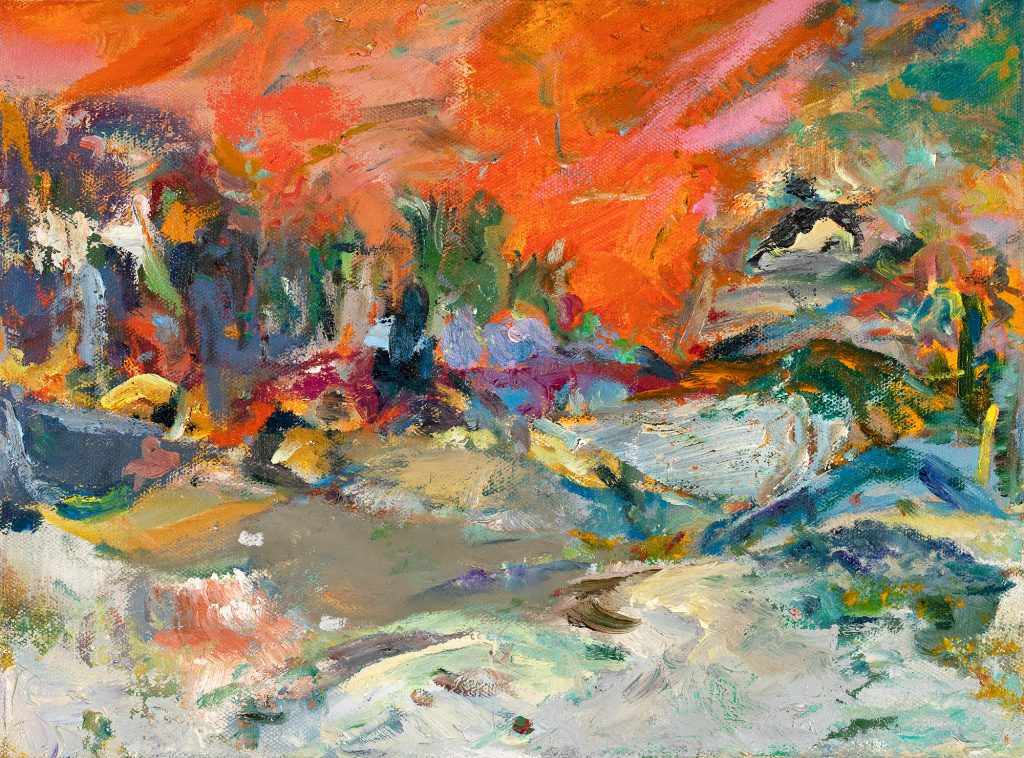
It’s like a feeling: There’s something happening that feels other than my normal inner thoughts. It’s like a pull toward something… something got in there… it’s nothing to do with my conscious mind. I didn’t decide to make a painting of that. It’s just: I saw something interesting, and it stayed in my mind. It stayed somewhere inside me, and kind of worked itself into a feeling that is potent and directed. It’s not my decision. That thing is in there, and I can choose whether to show up for it or not.
I feel like it’s kind of guiding me. I’m thinking of these two paintings that really just evolved out of that… I don’t think I would’ve decided to make those paintings. That’s when I know it’s good, because it’s not my conscious mental mind that’s saying, “I need to make this, and here it’s gonna be green or it’s gonna be this thing.” When I look at them later, I’m like, “Oh my god, that’s so strange.” And then if I go away from them, give it a break and come back, it’ll be like, “Oh, wow. That’s such a fully formed world.”
Those are the paintings that are really a gift. They come out parallel to my normal day-to-day experience where I’m driving and I’m getting gas and all that stuff. I’m gathering some kind of bread crumbs or some information that all adds up together to make that. And I don’t know what that is, and I don’t know where that comes from, but I think all of us have it. And that’s what’s so curious. We all feel touched by stuff, and I don’t think we can say verbally what it is, or why. But stuff gets in there. And I think we all share that, and that’s what’s so beautiful about painting to me.
How do you know when it’s finished? Does it stop talking to you, in a way?
Mm-hm. If it’s not finished, it bothers me. Like I’ll keep coming back to the painting and being like, “Yes?” (laughs) You’re saying something, and — it’s not as direct as a conversation, but there is usually a feeling of it being like, “I need some attention.”
Some of these things really take quite a while, which is so cool. I love that, too. Some of these paintings come out right away… and other ones take years to really come out.
Years, wow.
Yeah. Yeah. And it’s really just plumbing: “What are you holding back on?”… it’s just saying to let it be what it wants to be. You can’t protect certain areas of a painting and say, “Well, I like that part because that’s good.” It doesn’t add up. You have to be willing to let stuff go — paint it out, or change it, or really let it evolve away from an idea.
I’m curious, too, about the titles that you come up with for your work. I find myself looking back and forth between the title and the work, and almost feeling like I’m seeing a little bit of your process… are the works sort of telling you what they want to be called?
I think that’s really perceptive. Because it is a lot of times about process, where a word will come up… and it’s just like, “God, I love that word.” It’s another level of parallel.
And other times, well, I’m trying to be really conscious of not using a descriptive word. Like, I don’t want it to be literal and then it takes the mystery and fun out of it, right? So you’re not looking at a landscape and calling it “Landscape.”
I like it to be another level of information. Maybe slightly poetic; maybe slightly in a clue sense. You get another flavor, another layer… sometimes the word comes during the painting, sometimes it comes later. I have a list of words that I was really drawn to, and attached to; actually, several lists that I look at sometimes. It’s not like, “Oh, I will use these.” It’s just that I like these words, and if the painting arrives that is like, “Oh, that’s for you!” it’ll be like, “Oh, well, there it is! There’s the painting.”
I want to ask you about one painting specifically. It looked like a ribbon from a horse show, and it was called “Blues.” That kind of fascinated me because it didn’t look like a blue ribbon… I wondered if there was another story here, another level, like you’re saying. Maybe there was something sad, like you’ve got “the blues.” There was something about that stuck with me, and I thought: There’s a whole story here, and I’d love to hear the story.
I’m really pleased to hear that… that’s exactly my intention is to have that, where it kind of sticks with you and you’re like, “Oh, there’s definitely something else here,” and it evolves in your mind. I will tell you the story, but you don’t need to know the story… that’s the way I really like the paintings to be, to give you an experience of your own that you can carry forward.
It was intentional; “the blues” is absolutely right… after I graduated from SVA, my now-husband/then-boyfriend (artist Brian Wood) and I decided to move up to this area. We got the idea, because of my background, and I was really tired of New York at that point, and he’s from a farm in Saskatchewan, in Canada… that we would get a horse together. (laughs)
We moved up here in 2008 from New York, and I started a working at a local barn in North Chatham called Larkin Hill… my boss and trainer, Margie Hutchison at Larkin Hill, found this horse… at King Oak, nearby, these young thoroughbred boys, geldings. I went over to King Oak with Brian, my husband, and looked at all three. Brian immediately connected with Patrick, our horse… he just looked in his eyes. He’s very quiet, maybe a little bit withdrawn… but he was so right. He totally saw Patrick. We got him, and we had him together for three and a half years… he had some training, but not very much, so he was my project.
“Blues” comes from a period of time where I was trying to sell him.
So, knowing you’d have to say goodbye at some point.
Exactly. When I was at the barn, we did eventing and Patrick didn’t enjoy eventing. Patrick was always — even from the first second we saw him, he was built to be a hunter. The skill set, the discipline… he’s long, he’s big. He’s got a big stride, he’s got a long back, all that stuff. And he was very, very happy in that skill.
We had a lot of great, great years, and he really brought me back to my creativity. I didn’t make any paintings during that time — three and a half years, I made no paintings. Zero. Patrick was my creative experience at that time, and it was profound. He got injured twice; the second time was really, really bad. And it made me have to… take all of my assumptions back, start over entirely and just watch. Go really carefully and slowly and learn a completely new way of working with him, working with myself. It was really for the best, even though I remember how scary it was at the time and just devastating. But I’m really glad it happened because it made both of us enormously better.
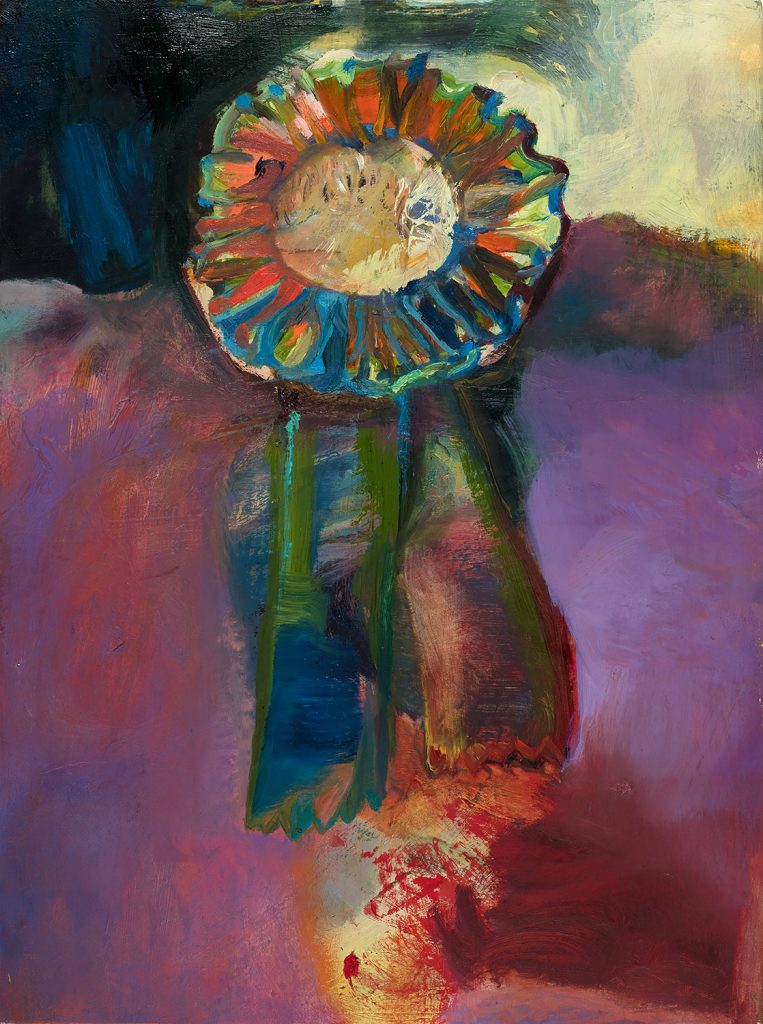
“Blues” was the hardship, the heartbreak of having to let him go. Because it was time; it needed to happen. I didn’t want to be a hunter; he needed to go to someone who would really enjoy that and do that, and they could do it together… “Blues” was about, “Yeah, he’s winning the shows; it’s cool.” I never had that experience when I was a kid: You go to all the shows, you win all the blues because that’s just how nice your horse is. That was Patrick. I finally got to live that when I was an adult… he gave me that.
So it was based on actual ribbons that he was winning.
Absolutely, and I was proud, but it was also heartbreaking because every time that happened, I could feel him moving further and further away from me. And I knew that he was going away, and that I was letting him go. The more this happened, the more he was growing away from me. It’s what I wanted; it was good, and I was proud. But it was also really sad, and really hard.
Why do you do what you do, Ashley? What makes it tick, this art that you’ve got inside you?
Well… as I’m thinking about this, I’m looking outside and it’s so beautiful, the snow and the way it’s moving. You know, the different snow, the way it comes down. And then the other day it was like ice, right, so it’s glinting. It’s shattered air. Right now, it’s snow, but it’s not coming down like big chunks; it’s not soft; it’s just kind of coming down a little bit. We know we’re getting more snow, and so it’s like, “Oh, it’s just starting… something’s happening.”
I think it has to do with curiosity. It has to do with interest in the world, engagement in the world, aliveness, and wanting to share that… This is something that blows my mind all the time: Even the most jaded people, in all kinds of walks of life — I will see it sometimes, on Instagram — post (a) picture of the sunset, and (they’ll) be like, “Aah.” And it’s like, that’s it, right? That’s that core piece of humanity that we all still have, no matter what… it’s almost innocent, that youthful aliveness of: “Oh my god, a sunset.” How profound that is! How beautiful that is!
I feel so moved by the land, the weather… because I just feel like it’s always guiding us, it’s kind of showing us a way, a new way to really pay attention, to be in ourselves, to be with ourselves. You know, winter: It’s not death, it’s not a quiet time, it’s not like hibernation. It’s totally alive. And it’s exposing all this stuff to us that we don’t get to see: Structure. The way the trees are. All this stuff is just information for us to be gathering, and to be like, “Here, let’s share it, as artists. Let’s look at this.” Let’s have this common human experience together and use the depth of that connection to make the next steps in what we need.
When we talked about your first horse, you said he was a great teacher. That resonates well with the way you talk about your art and how it guides you, and what you were saying just now about winter guiding us or nature guiding us: He was the teacher.
He really was… I remember when I rode him the first time and I felt something really powerful come over me that was not like, “Oh, he’ll win blue ribbons!” It was, no, something is really interesting here, and he was safe, and he was holding; it was all that. He was a teacher. He guided.
That’s the strange thing that’s not us, that we are in, that surrounds us, that we need to join with. That’s aliveness; that’s the world. And these other things that aren’t human, we can open up to them more and more and let them come in. And show us the way forward.

Find our Maker online: Website, Facebook, Instagram
Wish to nominate a Maker of the Week? Email nominations.

